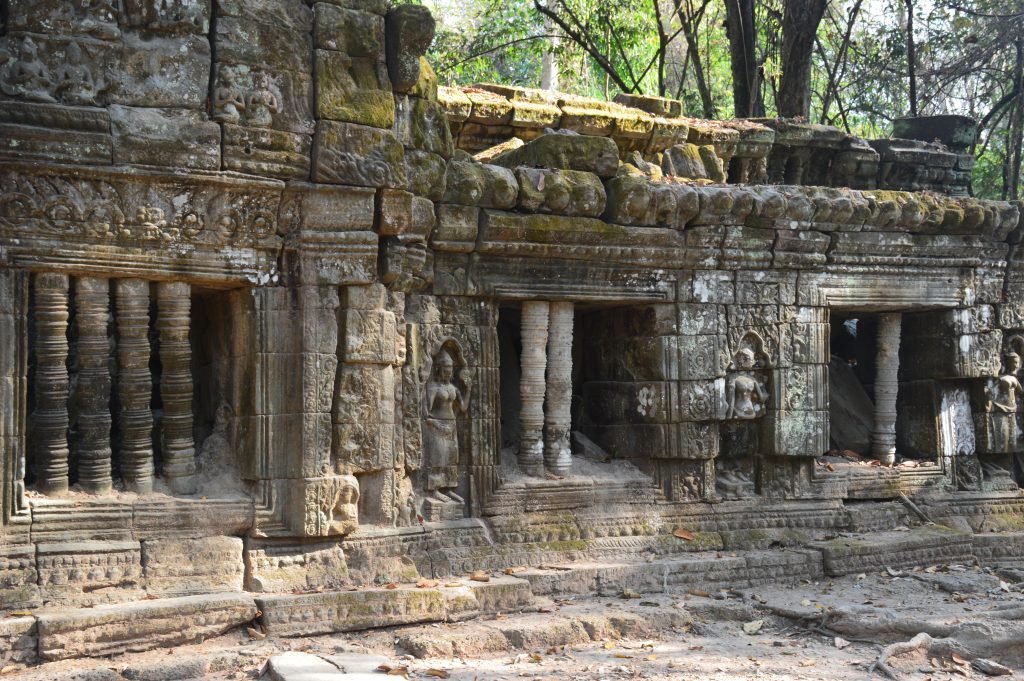
‘In every temple, a story unfolds, revealing the timeless allure of Cambodia’s soul.’ Siem Reap is a mind-blowing city that offers a mix of history, culture, and natural beauty, making it a must-visit place for anyone traveling to Cambodia. Imagine this: you’re wandering through the jungle canopy, sunlight filtering through the leaves, until a magnificent temple of carved sandstone emerges, whispering tales of a glorious Khmer empire. That’s the magic of Siem Reap – a place where history comes alive, and every corner promises an adventure.
Join me in today’s blog as we uncover the main attractions in Siem Reap, the best things to do, and a comprehensive 5-day itinerary for exploring the enchanting city.
Siem Reap is a city in northwestern Cambodia and the capital of Siem Reap Province. It is a popular tourist destination because of its proximity to the Angkor Archaeological Park, which contains the ruins of the ancient city of Angkor. Angkor was the capital of the Khmer Empire from the 9th to the 15th century and is one of the world’s most significant archaeological sites.
Siem Reap has grown significantly in recent years, with a range of accommodation options, restaurants, and nightlife. It has a charming and relaxed atmosphere, and many visitors use it as a base for exploring the nearby temples of Angkor.
Apart from the Angkor temples, there are various other Siem Reap attractions, such as the Angkor National Museum, the Landmine Museum, the floating village of Kampong Phluk, and the Tonle Sap Lake, which is the largest freshwater lake in Southeast Asia.
The city also hosts various cultural events throughout the year, such as the Angkor Photography Festival and the Angkor Wat International Half Marathon.

Siem Reap offers many attractions and activities for visitors. Here are some of the best things to do in Siem Reap:
We are avid users of the GPSmy City app, especially in cities lacking free walking tours. With over 1,000 cities covered, it’s a lifesaver! The best part? No data worries when you’re abroad—pre-download city guide sand enjoy offline use. In Siem Reap, GPSmy City provides complimentary walking tours, from temple expeditions to customizable adventures. Simply download the app, pick a tour, and explore at your leisure!
In Siem Reap, GuruWalk has several free walking tours available:
The tours are free, but please don’t forget to tip your hard-working guide. We usually give between $10-$20 depending on the quality and length of the tour.
Time to recharge those batteries for the exciting adventures ahead! Settle into your accommodations, unpack your belongings, and perhaps take a refreshing dip in the pool to cool off from the Cambodian heat. You’ll need all the energy you can muster because the next few days are jam-packed with excitement!
On our second full day in Siem Reap, we ventured into the mystical world of Ta Prohm. This site is also known as the Kingdom of Jungle or the Tomb Raider Temple (thanks, Angelina Jolie!). The ancient Ta Prohm was founded in the late 12th century as a Buddhist monastery and university. It has remained remarkably preserved, making it a paradise for photographers.
international fame after its appearance in the 2001 movie “Lara Croft: Tomb Raider,” and it’s easy to see why. The temple is a captivating blend of ancient architecture and nature’s reclaiming touch, with towering silk cotton and ficus trees growing out of the ruins.
While all the Angkor sites are awe-inspiring, Ta Prohm stands out for its jungle surroundings and the whimsical trees that seem to have a life of their own. It’s no wonder this site is one of the most visited in the Angkor region!

Siem Reap is a treasure trove of ancient wonders! One of its crown jewels is the magnificent Angkor Thom. Built back in the 12th century, this monumental city was the brainchild of King Jayavarman VII. He envisioned it as the grand finale capital of the Khmer Empire.

A fellow traveler said, “Standing there in Angkor Thom, surrounded by those massive stone faces, I couldn’t help but feel like I’d stepped back in time. It was like the history of Cambodia was whispering all around me.”
In its heyday, Angkor Thom was a bustling hub with a population that could rival a modern-day city, boasting between 80,000–150,000 residents. The city was no easy target, surrounded by massive walls and a moat spanning about 9 square kilometers, making it a real fortress. But these weren’t just any walls—they were adorned with stunning carvings depicting military and mythological scenes, showcasing the Khmer’s artistic prowess.
The star of the show at Angkor Thom is the Bayon temple, famous for its 216 enormous stone faces representing Avalokiteshvara, the Bodhisattva of compassion. Angkor Thom is a treasure trove of other temples and structures like the Baphuon temple, Phimeanakas temple, and the Terrace of the Elephants.
Angkor Thom was a vibrant hub of art, culture, and architecture, showcasing the Khmer people’s incredible talents. Even though it was abandoned in 1609, its ruins continue to captivate visitors from around the world, serving as a testament to Cambodia’s rich history and heritage.
Approaching the Bayon Temple feels like stepping into a giant history book but with a lot more charm and a few surprises along the way! This stunning temple, nestled at the heart of Angkor Thom, is a true marvel of ancient Khmer architecture. Built way back in the late 12th century, it’s a testament to the Khmer people’s incredible talent and creativity—just imagine, they built this masterpiece without any fancy machinery!
As you get closer, the temple’s size and intricate details start to sink in. The walls are like storybooks, covered in carvings that tell tales from Hindu mythology and history. But the real stars of the show are the over 200 serene stone faces that adorn the towers. These faces, believed to be of Avalokiteshvara, the Bodhisattva of compassion, add a mystical touch to the temple, making it feel like it’s watching over you.
You’ll want to take your time wandering around, admiring the craftsmanship, and soaking in the ancient vibes. And keep an eye out for the adorable monkeys that call the temple grounds home—they’re not just cute, but they also add a playful charm to this already enchanting site.
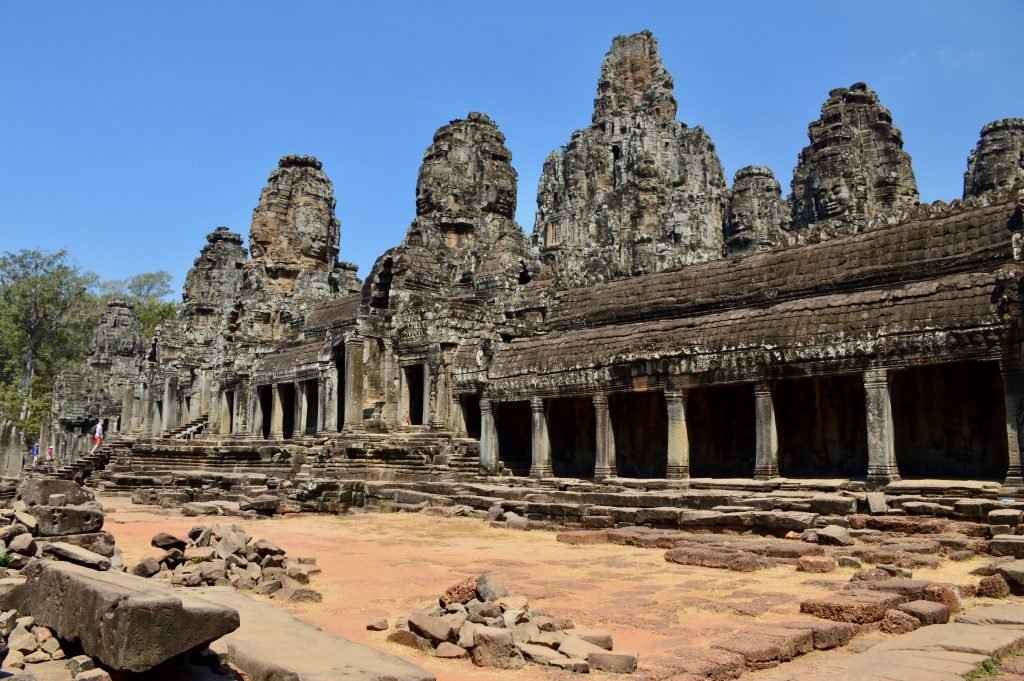
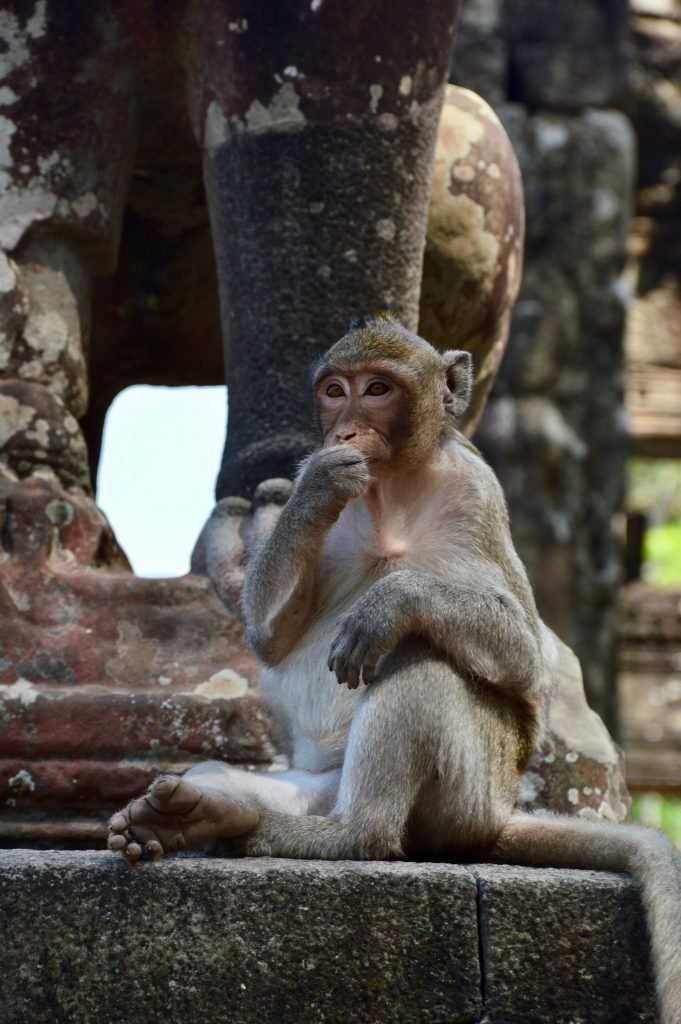
Step onto the Terrace of Elephants, and you’re stepping into a scene fit for a king—or, in this case, King Jayavarman VII! This majestic structure within Angkor Thom served as the ultimate royal balcony, where the king could watch his army return from battle, probably feeling a bit like Andy Reid in yet another Superbowl victory.
Stretching over 1,150 feet, the terrace is a parade of intricately carved elephants, each one telling a tale of power and triumph. With their trunks raised high in a trumpeting salute, these stone pachyderms are a symbol of victory and grandeur, showing off the Khmer Empire’s strength and artistic flair.
But beyond its ornate façade, the Terrace of Elephants was a focal point of Khmer life, hosting grand processions and important rituals that showcased the empire’s cultural richness. Picture the scene: the king and his retinue, surrounded by opulent festivities, gazing out from this elevated vantage point, feeling the weight of history and the expanse of their dominion.
In many ways, the terrace was a portal to the past, offering a glimpse into the glory days of the Khmer Empire and the majesty of its rulers. Today, as visitors tread its ancient stones, they can’t help but marvel at the timeless elegance and enduring legacy of this remarkable site.
When you’re ready to enter the ancient city of Angkor Thom, make your grand entrance through the South Gate! This gate is like the VIP lane to the city, with its impressive architecture and jaw-dropping artwork.
As you approach, you’ll first cross a majestic causeway stretching over a moat, setting the stage for the grandeur that awaits. Look to the sides, and you’ll see intricately carved railings telling the epic tale of the Churning of the Ocean, a battle between gods and demons for the elixir of immortality.
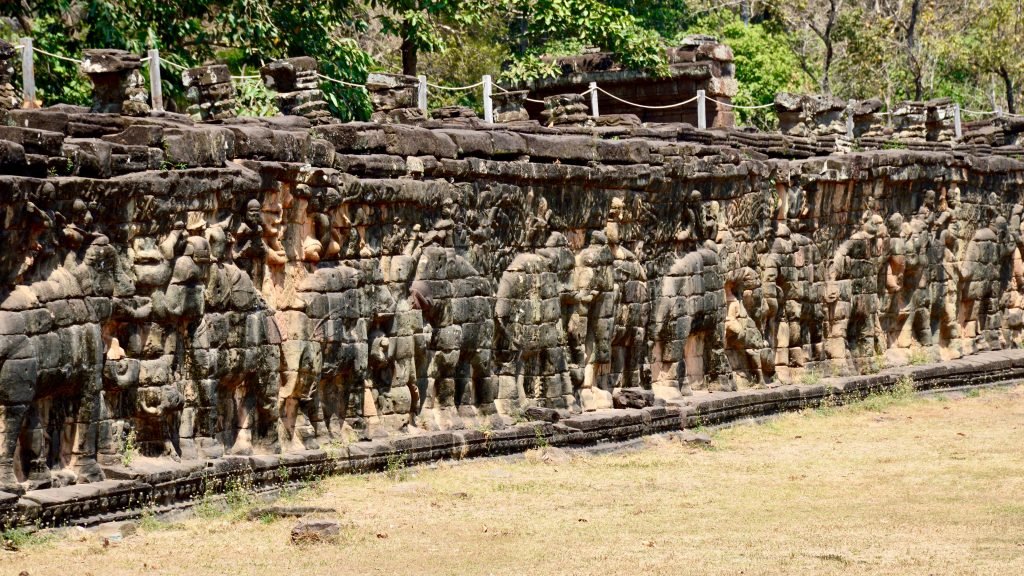
On one side of the railing, you’ll spot the gods pulling the head of a giant serpent, and on the other side, the demons pulling its tail. The serpent, coiled around a mountain, serves as the stirring stick in this cosmic cocktail mixer. As the gods and demons tug, the ocean churns, creating the mythical nectar.
As I stood before Angkor Thom’s South Gate, flanked by the stoic faces of gods and demons, I felt a connection to a world long past. The intricate carvings and towering stone figures seemed to whisper stories of ancient battles and royal triumphs, reminding me that history is not just read in books but felt in the presence of such awe-inspiring places.
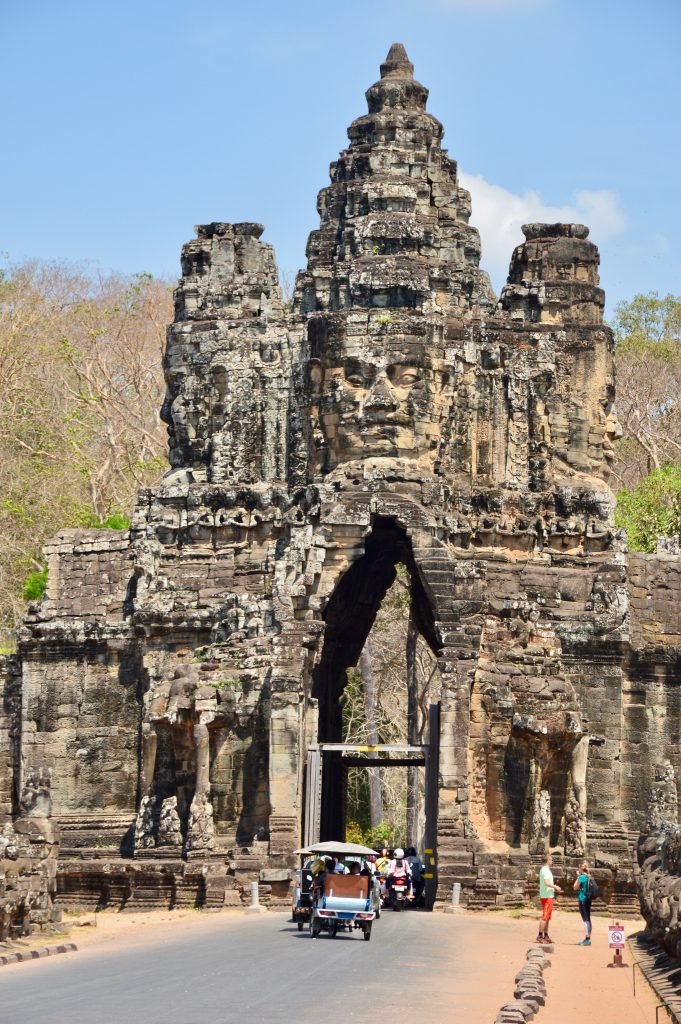
After a day of marveling at Siem Reap’s wonders, why not cap it off with a visit to another great Siem Reap attraction, the incredible Phare Circus? This isn’t just any circus; it’s a heartwarming celebration of Cambodian resilience and talent.
Founded by Cambodian refugees who returned home after the Khmer Rouge era, the Phare Circus teaches performing arts to disadvantaged youth. But it’s not just about supporting a good cause; it’s about experiencing an unforgettable show!
Under a big top tent, you’ll witness a dazzling blend of theater, acrobatics, and music, all woven with traditional Cambodian folk tales. The best part? These talented performers handle everything themselves, from designing sets to creating costumes.
Their stories range from ancient legends to modern-day tales, offering a rich glimpse into Cambodian history and culture. But what truly steals the show is the joy and passion radiating from the performers. Their infectious energy will sweep you off your feet and leave you in awe.
Phare Circus lasts about an hour, and it’s the best thing to do in Siem Reap at night. You can purchase tickets online for about $10.
Rise and shine! Time for an early morning adventure.
Set your alarm for 4:00 am because today’s itinerary begins with a spectacular sunrise at Angkor Wat. Trust us, seeing this architectural marvel at dawn is an experience you won’t want to miss!
Built in the 12th century, Angkor Wat was originally a Hindu temple dedicated to Vishnu before becoming a Buddhist temple. Today, it’s not just a religious site but an archaeological park that draws millions of visitors each year.
As you explore Angkor Wat, you’ll be amazed by its sheer size and intricate design. The five towers of the temple symbolize the peaks of Mount Meru, the home of the gods in Hindu mythology. The walls are adorned with thousands of carvings depicting deities and mythological figures.
Surrounded by a moat and towering walls, Angkor Wat’s grandeur is truly awe-inspiring. It covers over 200 acres, so be sure to wear comfy shoes and bring water for your visit.
One of the best times to visit is at sunrise, so prepare to join other early birds for this magical moment. Don’t forget to get your tickets in advance to avoid long lines.
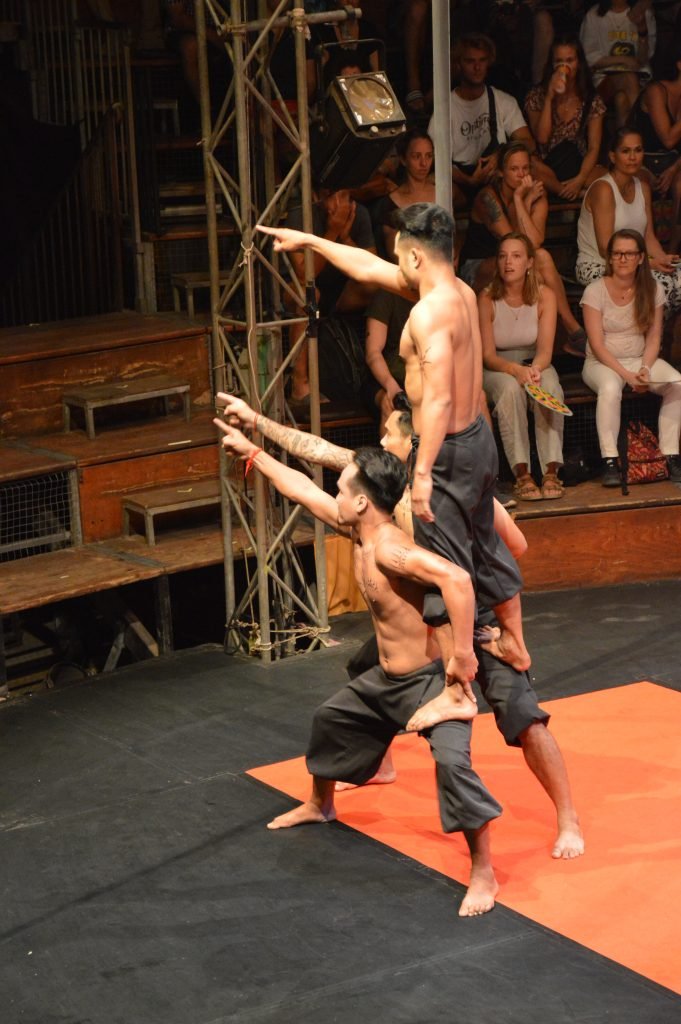
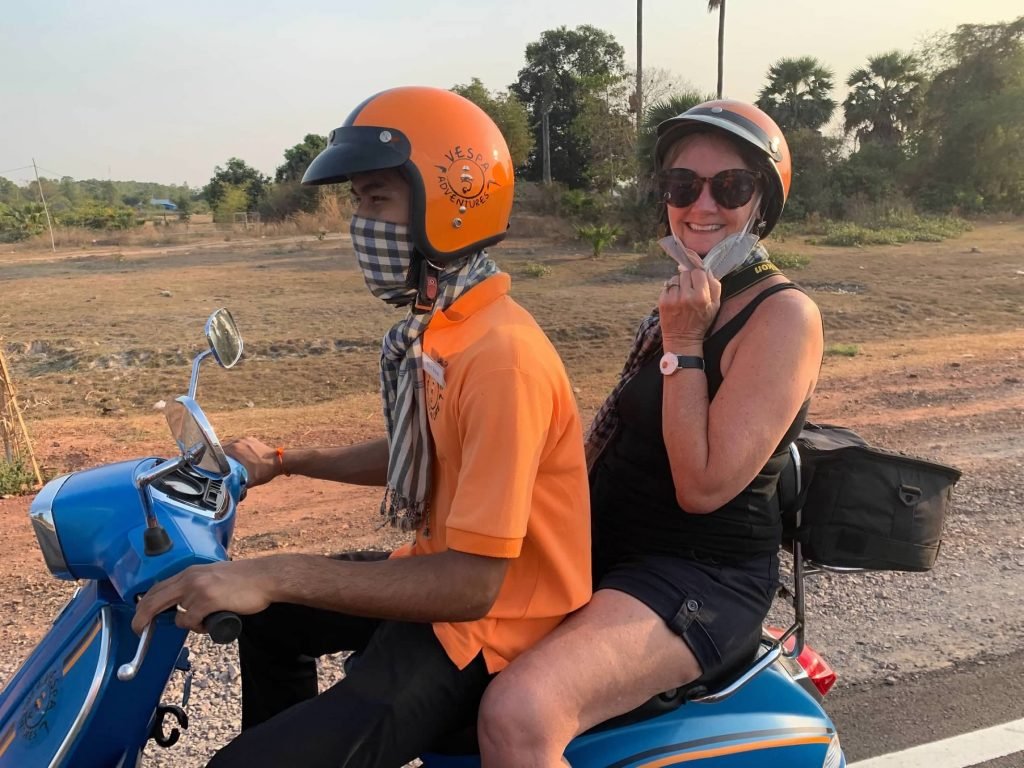
Ready for a unique adventure? After a day of temple hopping in Siem Reap, why not hop on a vintage Vespa for a leisurely tour through the lush countryside? Trust us, it’s worth it!
As the sun begins to set, cruise along dirt roads, passing rice paddies and water buffalos. You’ll stop at a Buddhist temple, where you can chat with novice monks and learn about their daily lives. Keep your eyes peeled for small villages, where you can witness local crafts like basket weaving and rice making in action.
With friendly families welcoming you into their homes, you’ll see traditional Cambodian life firsthand. The tour lasts three hours, with plenty of breaks to soak in the scenery and rest from the bumpy ride.
I’m not usually one to shop for souvenirs, but the Made in Cambodia Market turned out to be a pleasant surprise! We were nearing the end of our epic 3-month adventure through Australia, New Zealand, and Asia, and I was still empty-handed for my mom and her boyfriend, who had graciously cared for our cat during our travels.
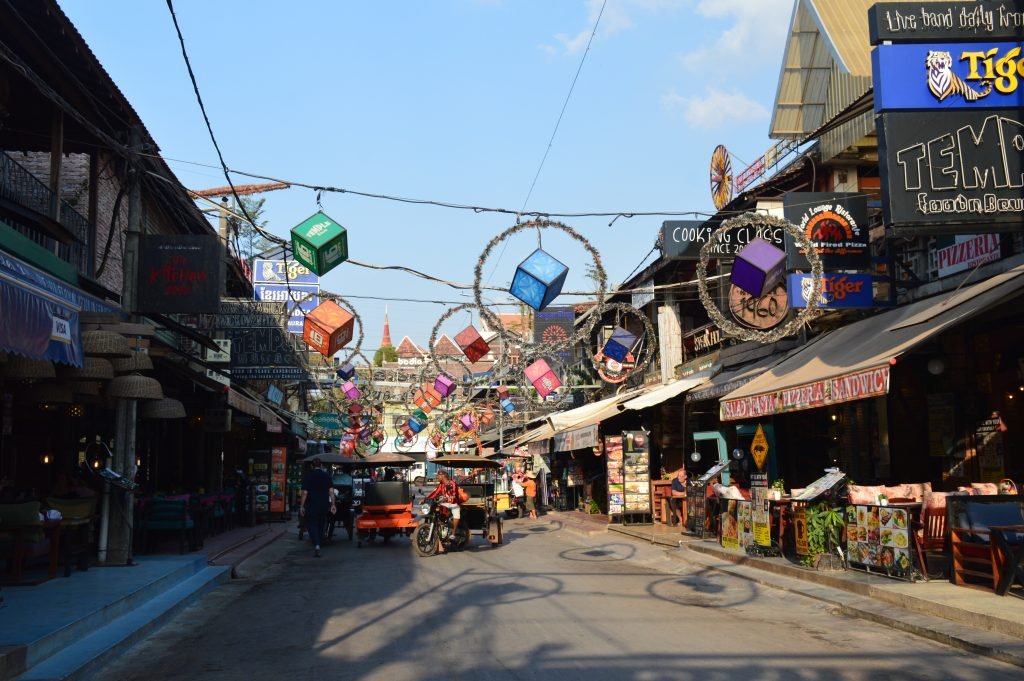
The market was a treasure trove of unique finds, all proudly made in Cambodia, not a “Made in China” sticker in sight! I picked up some beautiful earrings made from bullets from the Vietnam War, as well as some lovely Krama scarves. What’s even cooler is that all the goods are artisan-made by local craftsmen, and you can even meet some of the artists!
Bargaining is the name of the game here. We started negotiating a Khmer Crocodile Belt for my mom’s boyfriend at $60 USD, but after a little back-and-forth, we snagged it for half that price.
And when you need a break from shopping, there are plenty of restaurants and bars in the area to grab a bite and recharge before diving back into the shopping frenzy!
I’m a self-proclaimed ice cream enthusiast, and let me tell you, stumbling upon Original Cafe on Hospital Street was like finding a frozen treasure in the sweltering city heat! This little gem serves up some of the smoothest, most decadent ice cream I’ve ever tasted.
The magic happens right there in the shop, where the owner, Mr. Ratana Holly, whips up these creamy delights. You can feel the pride they take in their creations as they serve you up a scoop of happiness. My personal favorites? The Super Dark Chocolate, a rich and velvety dream, and the Vanilla Madagascar Bourbon, which is as indulgent as it sounds!
When the sun dips below the horizon in Siem Reap, Pub Street springs to life with a vibrant energy that’s hard to resist. Despite its petite size—just a mere 100 yards—this street packs a punch with its array of restaurants, clubs, and bars.
Once night falls, the street transforms into a pedestrian-only zone, ensuring a safe and enjoyable environment for revelers. As you walk down Pub Street, you’ll be greeted by a kaleidoscope of neon lights, and the sound of laughter and music will fill the air. It’s a lively scene, with Angkor beer flowing freely in nearly every establishment.
Feeling a bit hungry? Dive into Cambodian cuisine and sample some unique delicacies like deep-fried insects, snakes, or even crocodiles from the bustling street food carts. If you’re not feeling quite so adventurous, don’t worry—there are plenty of other delicious options to enjoy.
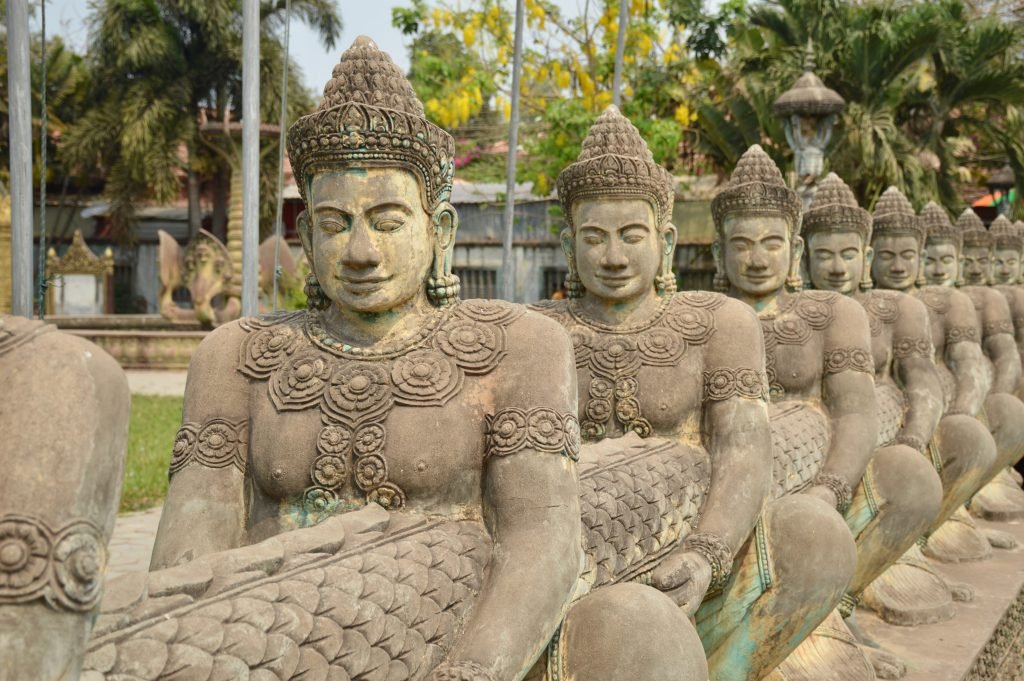
Before you bid farewell to Siem Reap, why not hop on a final TukTuk ride to uncover hidden Siem Reap attractions you might have missed? This last adventure offers a unique peek into local life, adding a deeper layer to your understanding of the city’s rich history and vibrant culture.
One intriguing stop is a roadside temple where the names of those lost during Pol Pot’s regime are engraved on the walls. It’s a poignant reminder of Cambodia’s tumultuous past. Yet, amidst the solemnity, you’ll witness the unwavering spirit of the Cambodian people, honoring their past with resilience and strength.
On our final day, our new buddies from the Emerald Waterways Mekong River Cruise had a wild suggestion: “Go see the rats at Apopo!” Now, I was a bit hesitant at first. Rats? Really? But let me tell you, these furry creatures blew us away!
First off, these African rats are no ordinary rodents. They’re as big as small dogs! And get this—they’re trained to be lifesavers, hence the name HeroRATs. Yep, you heard that right. Landmines from the Cambodian War still lurk in the countryside, posing a deadly threat. These rats, with their keen sense of smell and lightweight bodies, are trained to sniff out these explosives without setting them off.
We got to witness Bosco the Rat in action, and let me tell you; he’s a star! They strapped a little leash on him, plopped him in a sandbox at Apopo, and off he went, sniffing out TNT like a pro. Once he pinpointed the explosive, his human pals stepped in to safely dispose of it. See a video we took of Bosco sniffing out explosives here.
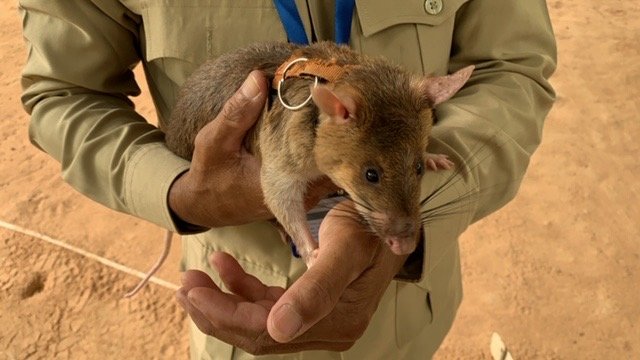
One of my friends mentioned, “Meeting the HeroRATs at Apopo was unlike anything I’ve ever experienced! These little guys weren’t just cute; they were heroes. Watching them sniff out landmines with such focus and dedication was awe-inspiring. It’s incredible to think these tiny creatures are saving lives and making Cambodia a safer place.”
But that’s not all these clever critters can do. They’re also trained to detect tuberculosis and other diseases, making them true heroes in the fight against these illnesses.
Apopo isn’t just about the rats; it’s about the amazing people behind the scenes. They treat these rodents like royalty, giving them top-notch care, yummy food, plenty of exercise, and loads of love.
So, the next time you think about rats, think again. These furry friends are making a real difference in the world. You can even adopt a rat or donate to Apopo to support their incredible work!
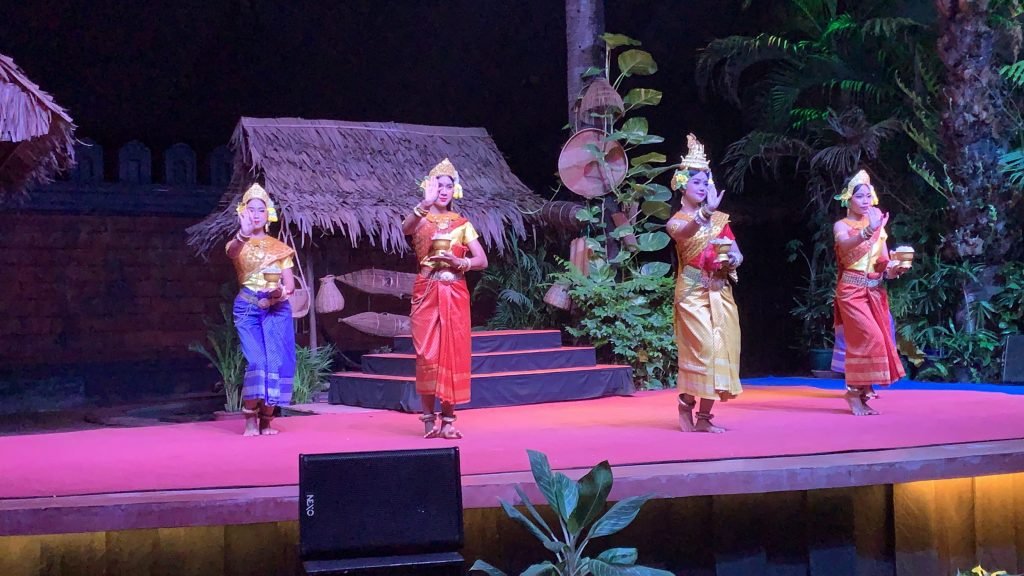
For your last night, why not feast on red ants? Yes, it’s on the menu at Kanell!
Our final evening with our Emerald Waterways “family” was spent at Kanell Restaurant, enjoying a traditional Apsara Dance Show while dining on some truly fabulous food.
The theater at Kanell is absolutely stunning, and the show was amazing—from the intricate costumes and beautiful performers to the enchanting music. The performers treated us to five captivating dances, each performed between meal courses:
The performances are interspersed between each meal course, allowing us to savor each dish prepared by the renowned Cambodian chefs, the Kimsan Twins. They offer two set menus: the Asian Fusion Menu and the Asian Fusion Deluxe Menu. We opted for the Asian Fusion Menu:
This magical evening at Kanell, with its blend of exquisite cuisine and mesmerizing performances, was a perfect way to conclude our journey.
Visit the Angkor National Museum: This museum is a great place to learn about the history and culture of the Khmer Empire, which ruled Cambodia for centuries. It features interactive exhibits and multimedia displays.
Take a boat tour of Tonle Sap Lake: Tonle Sap Lake is the largest freshwater lake in Southeast Asia and is home to a unique floating village. You can take a boat tour to learn about the local way of life and see the floating houses, schools, and markets.
Take a cooking class: Siem Reap has a rich culinary scene, and taking a cooking class is a great way to learn about Cambodian cuisine. You can visit a local market to buy ingredients and learn how to cook traditional dishes.
Khmer village: You can take a tour of a nearby village to learn about traditional Khmer culture and see how people live. You can visit a local school, see artisans at work, and try local foods.
These are just some of the things to do in Siem Reap. With its rich history, culture, and natural beauty, there’s no shortage of activities to keep visitors busy.
Fees: I recommend purchasing an Archaeological Site Pass starting at just $62 USD. This pass will get you into the entire Angkor Archaeological Park, and it’s good for 1 to 7 days.
Hours: Most of the temples are open from 7:30 am to 5:30 pm, but Angkor Wat is open at 5 am so that you can see it at sunrise.
See all Viator tours for Siem Reap, Cambodia.
Planning a trip around one of Siem Reap’s annual festivals and events can elevate your visit to a whole new level of cultural immersion. The city hosts a variety of vibrant celebrations throughout the year, each offering a unique glimpse into Cambodian traditions and communal spirit. From the colorful Water Festival (Bon Om Touk) with its exhilarating boat races on the Tonle Sap River to the spiritually enriching Khmer New Year (ChoulChnamThmey) featuring traditional games and rituals, these events provide a festive backdrop to your exploration of Angkor’s ancient temples. By timing your trip to coincide with these festivities, you’ll experience the rich cultural tapestry of Siem Reap in its most dynamic and lively form.
Learn more about Siem Reap’s annual festivals and events.
The best time to visit Siem Reap is during the dry season, which runs from November to April. During this time, the weather is generally sunny and dry, making it ideal for exploring the temples of Angkor and other outdoor activities.
The peak tourist season in Siem Reap is from December to February, so expect larger crowds and higher prices during this time. March to April can be quite hot, with temperatures often reaching above 95°F.
The rainy season in Siem Reap runs from May to October, and while the rainfall can be heavy, it usually comes in short bursts and doesn’t affect travel plans too much. However, the humidity can be high, making it uncomfortable for some travelers.
A typical stay in Siem Reap ranges from three to five days, but some travelers opt to stay longer. If you have more time, you can explore the surrounding countryside or take a day trip to the nearby town of Battambang.
Siem Reap is generally a safe destination for travelers, and violent crime against tourists is rare. However, like any tourist destination, it’s important to be aware of your surroundings and take necessary precautions to ensure your safety.
Ensuring your safety in Siem Reap requires a bit of awareness and caution. Here are some tips to help you stay secure:
Cambodian customs are heavily influenced by Buddhist beliefs, so it’s important to be respectful of local traditions while visiting Siem Reap. Here are some customs to be aware of:
By following these tips and being mindful of local customs, you’ll have a safe and respectful visit to Siem Reap.
A mid-range budget traveler can expect to spend around $50-$70 per day in Siem Reap, excluding airfare. This estimate can be adjusted depending on the traveler’s preferences and itinerary.
Siem Reap is located in northwestern Cambodia and can be accessed by air, road, and boat.
The most convenient way to get to Siem Reap is by air, as there are direct flights from several major cities in Asia, including Bangkok, Singapore, Kuala Lumpur, Ho Chi Minh City, and Hong Kong.
The Siem Reap International Airport is located about 8 km from the city center, and you can take a taxi or tuk-tuk to your hotel. Siem Reap has its own nice, small international airport, Siem Reap International Airport (REP). This airport services most major airlines throughout Asia. However, to get here from the United States or Europe, you’ll first have to fly into Phnom Penh, Bangkok, Ho Chi Minh City, or any of the other large cities, and then hop a flight to Siem Reap. See how to get the best deals on flights.
Siem Reap can be reached by road from other cities in Cambodia, such as Phnom Penh and Battambang. Buses are a popular and affordable way to travel, with several companies offering daily services. The journey from Phnom Penh takes about 6-7 hours, while the journey from Battambang takes about 3-4 hours.
It’s also possible to reach Siem Reap by boat from Phnom Penh or Battambang. This option is more scenic but takes longer and is subject to seasonal changes and water levels. Boats depart from the Phnom Penh port and the Battambang riverfront and can take up to 8-9 hours.
DON’T FORGET YOUR PASSPORT, and make sure your passport is up to date! Most countries will not permit you to enter unless your passport has more than six months remaining before it expires.
With ivisa.com, you can check to see what documents you will need to enter Cambodia, and you can apply right there for expedited travel documents, including visas and health declaration forms.
Siem Reap was our last stop on a Mekong River cruise that began in Ho Chi Minh City, Vietnam and ended in Siem Reap, Cambodia. See my separate post on our Mekong River Cruise.
Siem Reap has several transportation options for getting around the city and the surrounding areas:
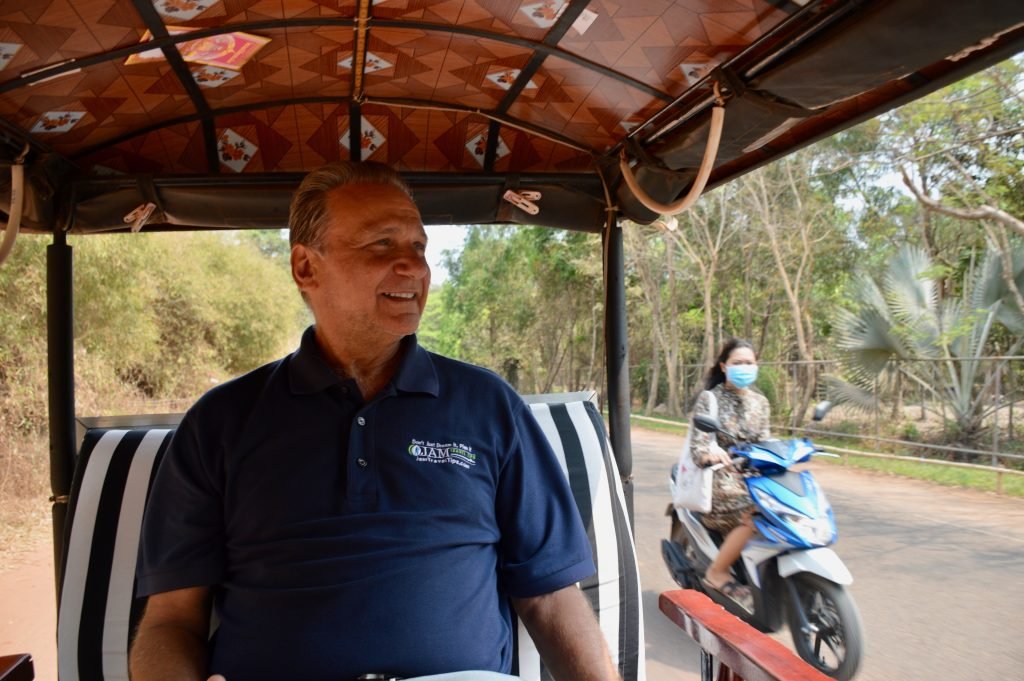
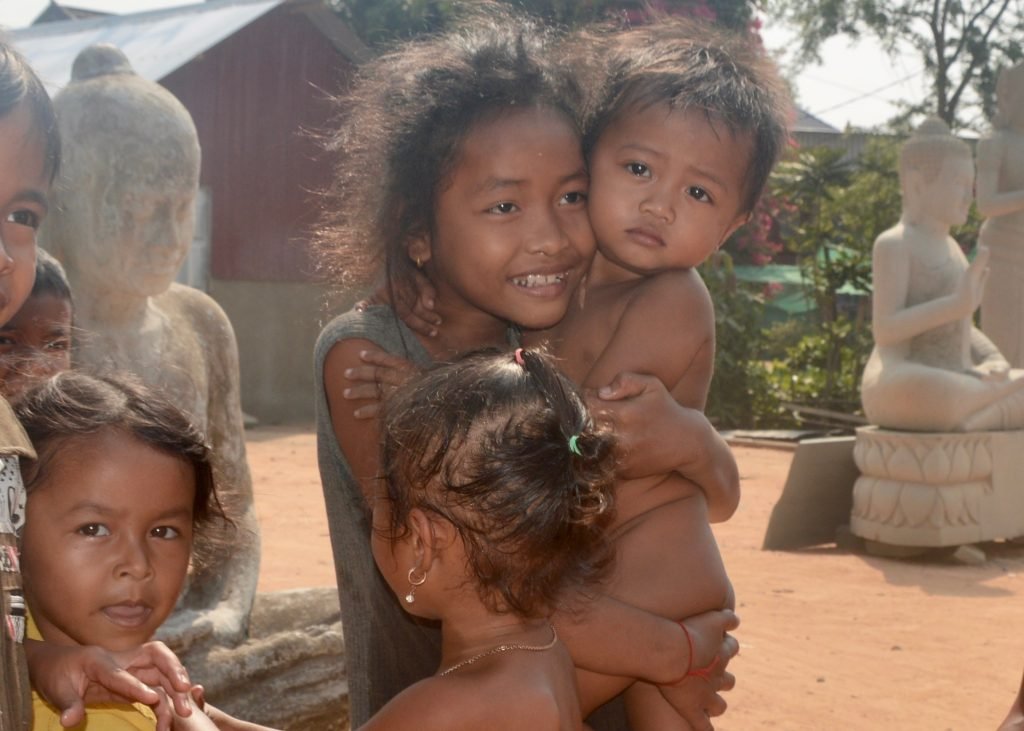
Siem Reap has a wide range of accommodation options to suit every budget and preference. Here are some popular areas and types of accommodation to consider when choosing where to stay in Siem Reap:
Shinta Mani: Emerald Waterways put our group up in a fabulous luxury boutique hotel called Shinta Mani Angkor. We had our own private villa-style room that was very large and very comfy! The pool and bar area were where we spent a lot of time, as well as in the restaurant on the grounds. This hotel is a great place to stay, and the staff is wonderful! Oh, and we had delicious fresh fruit and free bottled water in our room every day. But the best part about this hotel is that it is run by a charitable foundation. A percentage of the room rate goes to the local communities. I would not stay anywhere else in Siem Reap!
To get the best deal on rooms, go to Booking.com. For all other properties in Siem Reap, including hotels, B&Bs, and rental properties, go to Booking.com.
Siem Reap is known for its delicious Khmer cuisine, as well as its international food scene. Here are some popular areas and restaurants to try when looking for places to eat in Siem Reap:

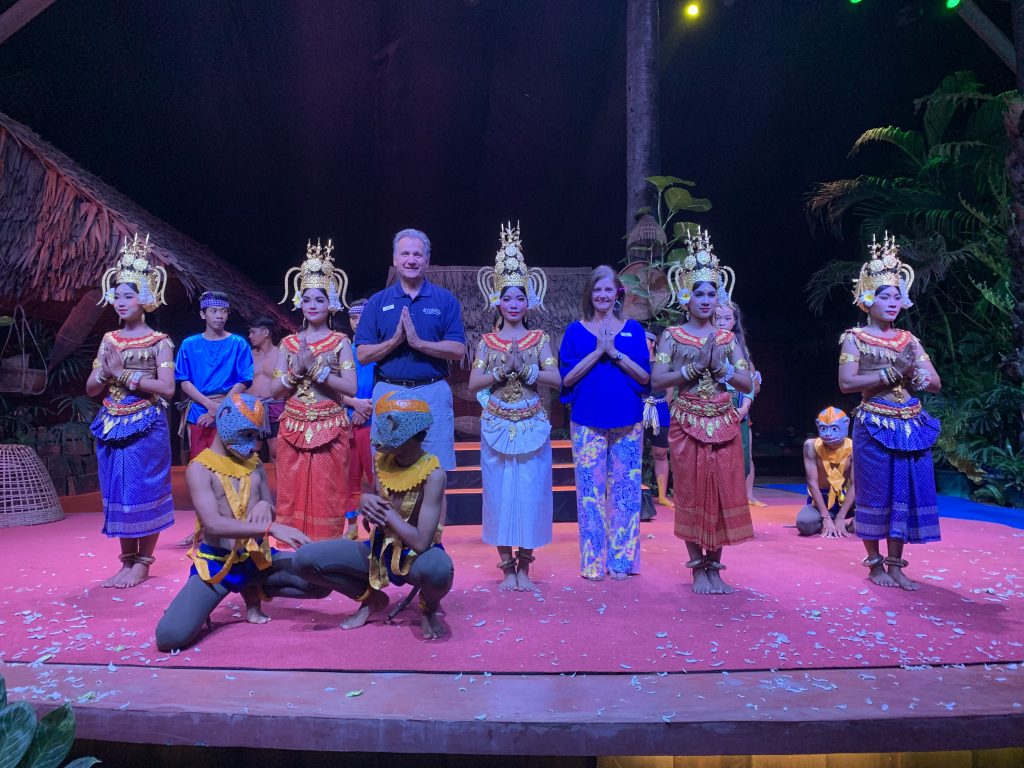 Dinner Show Siem Reap Cambodia" width="800" height="600" />
Dinner Show Siem Reap Cambodia" width="800" height="600" />
Siem Reap and the surrounding areas have been the location for several movies. Here are some movies that were filmed in Siem Reap:
Overall, Siem Reap’s stunning temples and natural beauty have made it an attractive location for movie producers. This comprehensive itinerary for Siem Reap encapsulates the essence of this captivating city, offering a perfect blend of ancient wonders, cultural experiences, and culinary delights. From exploring the magnificent temples of Angkor Wat and Angkor Thom to witnessing the vibrant Apsara Dance performances and indulging in authentic Cambodian cuisine, each day is filled with unforgettable adventures.
With its rich history, breathtaking landscapes, and warm hospitality, Siem Reap truly is a destination like no other. Whether you’re a history enthusiast, a culture seeker, or a food lover, this itinerary ensures that you make the most of your time in this remarkable city. So pack your bags, embark on this journey, and create memories that will last a lifetime. Don’t miss out on the best things to do in Siem Reap—start planning your Siem Reap 5-day itinerary today!
Siem Reap is a city in northwestern Cambodia and the capital of Siem Reap Province. It is a popular tourist destination because of its proximity to the Angkor Archaeological Park, which contains the ruins of the ancient city of Angkor. Angkor was the capital of the Khmer Empire from the 9th to the 15th century and is one of the world’s most significant archaeological sites.
Siem Reap has grown significantly in recent years, with a range of accommodation options, restaurants, and nightlife. It has a charming and relaxed atmosphere, and many visitors use it as a base for exploring the nearby temples of Angkor.
Apart from the Angkor temples, Siem Reap offers various other attractions, such as the Angkor National Museum, the Landmine Museum, the floating village of Kampong Phluk, and the Tonle Sap Lake, which is the largest freshwater lake in Southeast Asia.
The city also hosts various cultural events throughout the year, such as the Angkor Photography Festival and the Angkor Wat International Half Marathon.
Siem Reap offers many attractions and activities for visitors. Here are some of the things to do in Siem Reap:
We’re big fans of the GPSmyCity app, especially when we’re in cities without free walking tours. With over 1,000 cities covered, it’s a lifesaver! The best part? No data worries when you’re abroad – just download the city info beforehand and use the app offline. In Siem Reap, GPSmyCity offers free walking tours, including temple tours, or you can create your own adventure. Simply download the app, pick a tour, and explore at your leisure!
In Siem Reap, GuruWalk has several free walking tours available:
The tours are free, but please don’t forget to tip your hard working guide. We usually give between $10-$20 depending on the quality and length of the tour.
Time to recharge those batteries for the exciting adventures ahead! Get settled into your digs, unpack, and maybe even splash around in the pool to beat the Cambodian heat. You’ll need all the energy you can muster because the next few days are jam-packed with excitement!
On our second full day in Siem Reap, we ventured into the mystical world of Ta Prohm. This site is also known as the Kingdom of Jungle or the Tomb Raider Temple (thanks, Angelina Jolie!). The ancient Ta Prohm was founded in the late 12th century as a Buddhist monastery and university. It has remained remarkably preserved, making it a paradise for photographers.
Ta Prohm gained international fame after its appearance in the 2001 movie “Lara Croft: Tomb Raider,” and it’s easy to see why. The temple is a captivating blend of ancient architecture and nature’s reclaiming touch, with towering silk cotton and ficus trees growing out of the ruins.
While all the Angkor sites are awe-inspiring, Ta Prohm stands out for its jungle surroundings and the whimsical trees that seem to have a life of their own. It’s no wonder this site is one of the most visited in the Angkor region!


Siem Reap is a treasure trove of ancient wonders! One of its crown jewels is the magnificent Angkor Thom. Built back in the 12th century, this monumental city was the brainchild of King Jayavarman VII. He envisioned it as the grand finale capital of the Khmer Empire.
In its heyday, Angkor Thom was a bustling hub with a population that could rival a modern-day city, boasting between 80,000 to 150,000 residents. The city was no easy target, surrounded by massive walls and a moat spanning about 9 square kilometers, making it a real fortress. But these weren’t just any walls—they were adorned with stunning carvings depicting military and mythological scenes, showcasing the Khmer’s artistic prowess.
The star of the show at Angkor Thom is the Bayon temple, famous for its 216 enormous stone faces representing Avalokiteshvara, the Bodhisattva of compassion. Angkor Thom is a treasure trove of other temples and structures like the Baphuon temple, Phimeanakas temple, and the Terrace of the Elephants.
Angkor Thom was a vibrant hub of art, culture, and architecture, showcasing the Khmer people’s incredible talents. Even though it was abandoned in 1609, its ruins continue to captivate visitors from around the world, serving as a testament to Cambodia’s rich history and heritage.
Approaching the Bayon Temple feels like stepping into a giant history book, but with a lot more charm and a few surprises along the way! This stunning temple, nestled at the heart of Angkor Thom, is a true marvel of ancient Khmer architecture. Built way back in the late 12th century, it’s a testament to the Khmer people’s incredible talent and creativity—just imagine, they built this masterpiece without any fancy machinery!
As you get closer, the temple’s size and intricate details start to sink in. The walls are like storybooks, covered in carvings that tell tales from Hindu mythology and history. But the real stars of the show are the over 200 serene stone faces that adorn the towers. These faces, believed to be of Avalokiteshvara, the Bodhisattva of compassion, add a mystical touch to the temple, making it feel like it’s watching over you.
You’ll want to take your time wandering around, admiring the craftsmanship and soaking in the ancient vibes. And keep an eye out for the adorable monkeys that call the temple grounds home—they’re not just cute, but they also add a playful charm to this already enchanting site.


Step onto the Terrace of Elephants, and you’re stepping into a scene fit for a king—or in this case, King Jayavarman VII! This majestic structure within Angkor Thom served as the ultimate royal balcony, where the king could watch his army return from battle, probably feeling a bit like Andy Reid in yet another Superbowl victory. 🤣
Stretching over 1,150 feet, the terrace is a parade of intricately carved elephants, each one telling a tale of power and triumph. With their trunks raised high in a trumpeting salute, these stone pachyderms are a symbol of victory and grandeur, showing off the Khmer Empire’s strength and artistic flair.
But the Terrace of Elephants wasn’t just for royal spectating. It was also the stage for some of the empire’s most important ceremonies and processions. Picture it: grand events unfolding against the backdrop of this massive terrace, with the king and his courtiers looking out over the festivities, feeling like they’re on top of the world.

When you’re ready to enter the ancient city of Angkor Thom, make your grand entrance through the South Gate! This gate is like the VIP lane to the city, with its impressive architecture and jaw-dropping artwork.
As you make your approach, you’ll first cross a majestic causeway that stretches over a moat, setting the stage for the grandeur that awaits. Look to the sides, and you’ll see intricately carved railings telling the epic tale of the Churning of the Ocean, a battle between gods and demons for the elixir of immortality.
On one side of the railing, you’ll spot the gods pulling the head of a giant serpent, and on the other side, the demons pulling its tail. The serpent, coiled around a mountain, serves as the stirring stick in this cosmic cocktail mixer. As the gods and demons tug, the ocean churns, creating the mythical nectar.


After a day of marveling at Siem Reap’s wonders, why not cap it off with a visit to the incredible Phare Circus? This circus isn’t just any circus; it’s a heartwarming tale of Cambodian resilience and talent.
Founded by Cambodian refugees who returned home after the Khmer Rouge era, the Phare Circus teaches performing arts to disadvantaged youth. But it’s not just about the good cause; it’s about the amazing show they put on!
Under a big top tent, you’ll be treated to a spectacle of theater, acrobatics, and music, all infused with traditional Cambodian folk tales. The best part? These talented performers do everything themselves, from designing sets to creating costumes.
The stories they tell range from ancient legends to modern-day tales, giving you a glimpse into Cambodian history and culture. But what really steals the show is the sheer joy and passion the performers exude. You can’t help but get caught up in their infectious energy.
Phare Circus lasts about an hour, and it’s the perfect night out in Siem Reap. You can purchase tickets online from about $10 USD.

Rise and shine! Set your alarm for 4:00 am because today’s adventure begins with a spectacular sunrise at Angkor Wat. Trust us, seeing this architectural marvel at dawn is an experience you won’t want to miss!
Built in the 12th century, Angkor Wat was originally a Hindu temple dedicated to Vishnu before becoming a Buddhist temple. Today, it’s not just a religious site but an archaeological park that draws millions of visitors each year.
As you explore Angkor Wat, you’ll be amazed by its sheer size and intricate design. The five towers of the temple symbolize the peaks of Mount Meru, the home of the gods in Hindu mythology. The walls are adorned with thousands of carvings depicting deities and mythological figures.
Surrounded by a moat and towering walls, Angkor Wat’s grandeur is truly awe-inspiring. It covers over 200 acres, so be sure to wear comfy shoes and bring water for your visit.
One of the best times to visit is at sunrise, so prepare to join other early birds for this magical moment. Don’t forget to get your tickets in advance to avoid long lines.



Ready for a unique adventure? After a day of temple hopping in Siem Reap, why not hop on a vintage Vespa for a leisurely tour through the lush countryside? Trust us, it’s worth it!
As the sun begins to set, cruise along dirt roads, passing rice paddies and water buffalos. You’ll stop at a Buddhist temple, where you can chat with novice monks and learn about their daily lives. Keep your eyes peeled for small villages, where you can witness local crafts like basket weaving and rice making in action.
With friendly families welcoming you into their homes, you’ll get a firsthand look at traditional Cambodian life. The tour lasts three hours, with plenty of breaks to soak in the scenery and rest from the bumpy ride.



I’m not usually one to shop for souvenirs, but the Made in Cambodia Market turned out to be a pleasant surprise! We were nearing the end of our epic 3-month adventure through Australia, New Zealand, and Asia, and I was still empty-handed for my mom and her boyfriend, who had graciously cared for our cat during our travels.
The market was a treasure trove of unique finds, all proudly made in Cambodia, not a “Made in China” sticker in sight! I picked up some beautiful earrings made from bullets from the Vietnam War, as well as some lovely Krama scarves. What’s cool is that all the goods are artisan-made by local craftsmen, and you can even meet some of the artists!
Bargaining is the name of the game here. We started negotiating a Khmer Crocodile Belt for my mom’s boyfriend at $60 USD, but with a little back-and-forth, we snagged it for half that price.
And when you need a break from shopping, there are plenty of restaurants and bars in the area to grab a bite and recharge before diving back into the shopping frenzy!
I’m a self-proclaimed ice cream enthusiast, and let me tell you, stumbling upon Original Cafe on Hospital Street was like finding a frozen treasure in the sweltering city heat! This little gem serves up some of the smoothest, most decadent ice cream I’ve ever tasted.
The magic happens right there in the shop, where the owner, Mr. Ratana Holly, whips up these creamy delights. You can feel the pride they take in their creations as they serve you up a scoop of happiness. My personal favorites? The Super Dark Chocolate, a rich and velvety dream, and the Vanilla Madagascar Bourbon, which is as indulgent as it sounds!
When the sun dips below the horizon in Siem Reap, Pub Street springs to life with a vibrant energy that’s hard to resist. Despite its petite size—just a mere 100 yards—this street packs a punch with its array of restaurants, clubs, and bars. Once night falls, the street is transformed into a pedestrian-only zone, ensuring a safe and enjoyable environment for revelers.
As you amble down Pub Street, you’ll be greeted by a kaleidoscope of neon lights, and the sound of laughter and music will fill the air. It’s a lively scene, with Angkor beer flowing freely in nearly every establishment. Feeling a bit hungry? Why not venture into the realm of Cambodian delicacies and sample some deep-fried insects, snakes, or even crocodiles from the food carts that line the street? For the less adventurous, fear not—there are plenty of other delectable options to choose from.

Before you bid farewell to Siem Reap, why not hop on a final Tuk Tuk ride to uncover hidden gems you might have missed? This last adventure offers a unique peek into local life, adding a deeper layer to your understanding of the city’s rich history and vibrant culture.
One intriguing stop is a roadside temple where the names of those lost during Pol Pot’s regime are engraved on the walls. It’s a poignant reminder of Cambodia’s tumultuous past. Yet, amidst the solemnity, you’ll witness the unwavering spirit of the Cambodian people, honoring their past with resilience and strength.

On our final day, our new buddies from the Emerald Waterways Mekong River Cruise had a wild suggestion: “Go see the rats at Apopo!” Now, I was a bit hesitant at first. Rats? Really? But let me tell you, these furry creatures blew us away!
First off, these African rats are no ordinary rodents. They’re as big as small dogs! And get this—they’re trained to be lifesavers. Yep, you heard that right. Landmines from the Cambodian War still lurk in the countryside, posing a deadly threat. These rats, with their keen sense of smell and lightweight bodies, are trained to sniff out these explosives without setting them off.
We got to witness Bosco the Rat in action, and let me tell you, he’s a star! They strapped a little leash on him, plopped him in a sandbox at Apopo, and off he went, sniffing out TNT like a pro. Once he pinpointed the explosive, his human pals stepped in to safely dispose of it. See a video we took of Bosco sniffing out explosives here.
But that’s not all these clever critters can do. They’re also trained to detect tuberculosis and other diseases, making them true heroes in the fight against these illnesses.
Apopo isn’t just about the rats; it’s about the amazing people behind the scenes. They treat these rodents like royalty, giving them top-notch care, yummy food, plenty of exercise, and loads of love.
So, the next time you think about rats, think again. These furry friends are making a real difference in the world. You can even adopt a rat or donate to Apopo to support their incredible work!

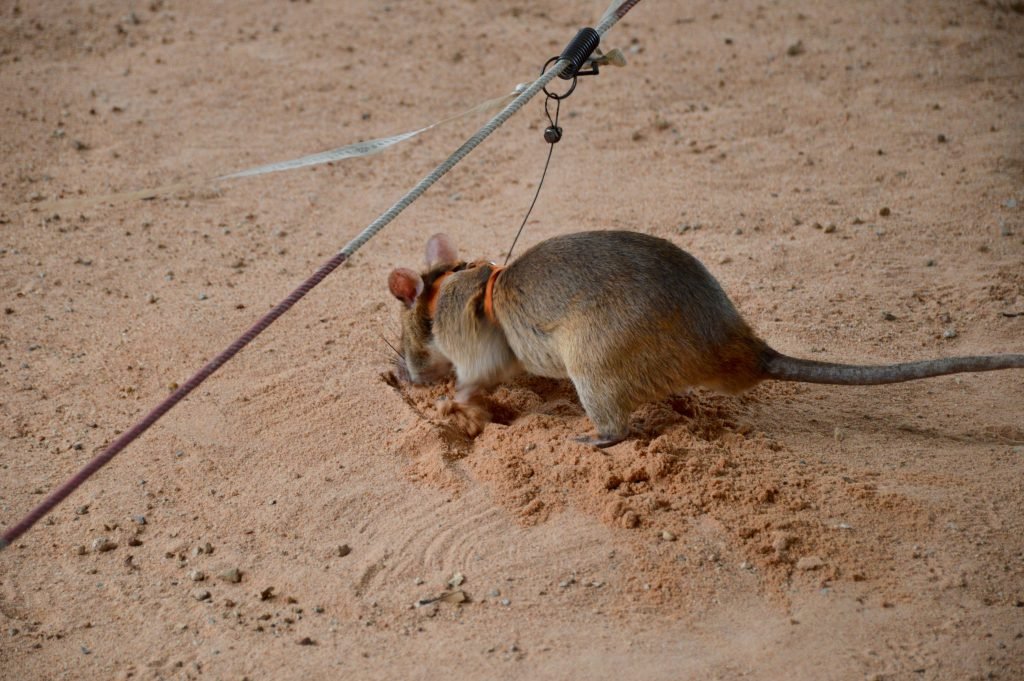
For your last night, feast on red ants… what? Yes, it’s on the menu at Kanell!
Our last night with our Emerald Waterways “family” was spent at Kanell Restaurant for a traditional Apsara Dance Show, while dining on some really fabulous food.
The theater at Kanell is absolutely stunning, and the show was amazing… from the costumes and beautiful performers to the music. They performed 5 dances in between each meal course:
The performances take place in between each meal course. Meals are expertly prepared and beautifully presented by famous Cambodian chefs, the Kimsan Twins. They offer 2 different set menus: the Asian Fusion Menu and the Asian Fusion Deluxe Menu. We had the Asian Fusion Menu:

These are just some of the things to do in Siem Reap. With its rich history, culture, and natural beauty, there’s no shortage of activities to keep visitors busy.
I recommend purchasing an Archaeological Site Pass starting at just $62 USD. This pass will get you into the entire Angkor Archaeological Park, and it’s good for 1 to 7 days.
Most of the temples are open from 7:30am to 5:30pm, but Angkor Wat is open at 5am so you can see it at sunrise.
See all Viator tours for Siem Reap, Cambodia.
Plan a trip around one of Siem Reap’s annual festivals and events.
The best time to visit Siem Reap is during the dry season, which runs from November to April. During this time, the weather is generally sunny and dry, making it ideal for exploring the temples of Angkor and other outdoor activities.
The peak tourist season in Siem Reap is from December to February, so expect larger crowds and higher prices during this time. March to April can be quite hot, with temperatures often reaching above 95°F.
The rainy season in Siem Reap runs from May to October, and while the rainfall can be heavy, it usually comes in short bursts and doesn’t affect travel plans too much. However, the humidity can be high, making it uncomfortable for some travelers.
A typical stay in Siem Reap ranges from three to five days, but some travelers opt to stay longer. If you have more time, you can explore the surrounding countryside or take a day trip to the nearby town of Battambang.
Siem Reap is generally a safe destination for travelers, and violent crime against tourists is rare. However, like any tourist destination, it’s important to be aware of your surroundings and take necessary precautions to ensure your safety.
Here are some tips to stay safe in Siem Reap:
Cambodian customs are heavily influenced by Buddhist beliefs, so it’s important to be respectful of local customs and traditions while visiting Siem Reap. Here are some customs to be aware of:
A mid-range budget traveler can expect to spend around $50-$70 per day in Siem Reap, excluding airfare. This estimate can be adjusted depending on the traveler’s preferences and itinerary.
Siem Reap is located in northwestern Cambodia and can be accessed by air, road, and boat.
Fly
The most convenient way to get to Siem Reap is by air, as there are direct flights from several major cities in Asia, including Bangkok, Singapore, Kuala Lumpur, Ho Chi Minh City, and Hong Kong. The Siem Reap International Airport is located about 8 km from the city center, and you can take a taxi or tuk-tuk to your hotel. Siem Reap has its own nice, small international airport, Siem Reap International Airport (REP). This airport services most major airlines throughout Asia. However, to get here from the United States or Europe, you’ll first have to fly into Phnom Penh, Bangkok, Ho Chi Minh City, or any of the other large cities, and then hop a flight to Siem Reap. See how to get the best deals on flights .
Siem Reap can be reached by road from other cities in Cambodia, such as Phnom Penh and Battambang. Buses are a popular and affordable way to travel, with several companies offering daily services. The journey from Phnom Penh takes about 6-7 hours, while the journey from Battambang takes about 3-4 hours.
It’s also possible to reach Siem Reap by boat from Phnom Penh or Battambang. This option is more scenic but takes longer and is subject to seasonal changes and water levels. Boats depart from the Phnom Penh port and the Battambang riverfront and can take up to 8-9 hours.
DON’T FORGET YOUR PASSPORT, and make sure your passport is up to date! Most countries will not permit you to enter unless your passport has more than six months remaining before it expires.
With ivisa.com, you can check to see what documents you will need to enter Cambodia, and you can apply right there for expedited travel documents, including visas and health declaration forms.

Siem Reap was our last stop on a Mekong River cruise that began in Ho Chi Minh City, Vietnam and ended in Siem Reap, Cambodia. See my separate post on our Mekong River Cruise.
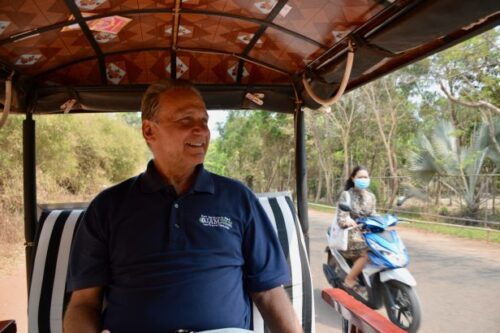
Siem Reap has several transportation options for getting around the city and the surrounding areas:
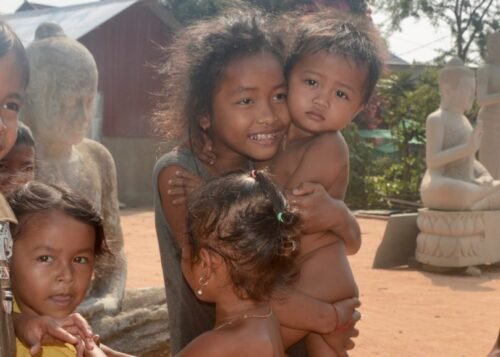
Siem Reap has a wide range of accommodation options to suit every budget and preference. Here are some popular areas and types of accommodation to consider when choosing where to stay in Siem Reap:
Emerald Waterways put our group up in a fabulous luxury boutique hotel called Shinta Mani Angkor. We had our own private villa-style room that was very large and very comfy! The pool and bar area were where we spent a lot of time, as well as in the restaurant on the grounds. This hotel is a great place to stay, and the staff is wonderful! Oh, and we had delicious fresh fruit and free bottled water in our room every day. But the best part about this hotel is that it is run by a charitable foundation. A percentage of the room rate goes to the local communities.
I would not stay anywhere else in Siem Reap! To get the best deal on rooms, go to Booking.com. For all other properties in Siem Reap, including hotels, B&Bs and rental properties, go to Booking.com.

Siem Reap is known for its delicious Khmer cuisine, as well as its international food scene. Here are some popular areas and restaurants to try when looking for places to eat in Siem Reap:
See above (Itinerary for day 5) for the fabulous dinner and dance show at Kanell Restaurant. Get your dinner and show ticket here.
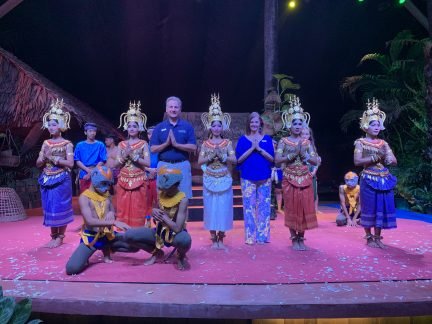 Dinner Show Siem Reap Cambodia" width="432" height="324" />
Dinner Show Siem Reap Cambodia" width="432" height="324" />
At Viroths we had some amazing Khmer cuisine… Pork Curry, Grilled Chicken Satay, Pork Lamb, delicious sticky rice. It is a chick 2-story restaurant. They have three different areas in which you can dine. Downstairs you can eat outside in the open area or in the garden, and upstairs you can have air conditioning!! The food is great, and the beer is ice cold! The restaurant is open daily from 10am – 10pm.
We found some excellent Italian food in Siem Reap! The owner of La Bruschetta, Fabio, is from Puglia, Italy. His restaurant is just off Pub Street, in a tiny place with only about 6 tables and a very small menu. The meatballs are some of the best we’ve ever had. Homemade Tagliatelle with Duck Bolognese, and Lasagne with Béchamel… absolutely delicious! Bravo Fabio!
Siem Reap and the surrounding areas have been the location for several movies. Here are some movies that were filmed in Siem Reap:
Overall, Siem Reap’s stunning temples and natural beauty have made it an attractive location for movie producers.